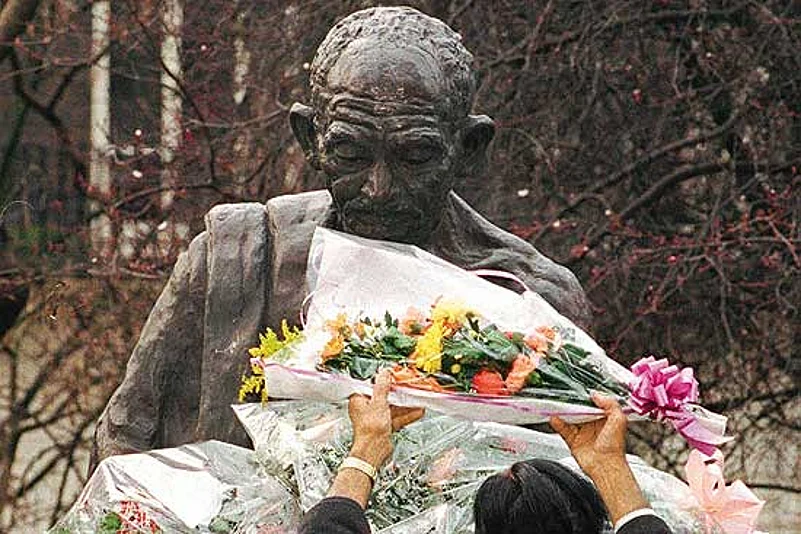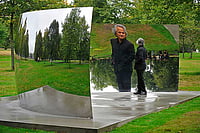In bronze, as in life, it seems Mohandas Karamchand Gandhi is causing storms in the United Kingdom. In what seemed to be a fairly obvious, if borderline obsequious, gesture of friendship on a recent trade mission to India, the British chancellor of the exchequer, George Osborne, proposed that a statue to Mahatma Gandhi be erected outside the British Parliament at Westminster in London.
The figure will join a long list of luminaries standing around the buildings representing the world’s oldest parliamentary democracy. The area has no less than 12 statues immortalising figures from domestic and foreign history, among them distinguished British prime ministers like Benjamin Disraeli and Winston Churchill and international figures like Abraham Lincoln and Nelson Mandela.
One of the main objections has been whether public funds should be used for such a venture. After all, there’s already a statue of Gandhi at Tavistock Square, just two miles from Parliament. Another objection is whether Britain does not have an icon from its own history to instal a statue of? Is there no room to honour the Chartists, the Anti-Corn Law League or the Tolpuddle Martyrs in a space where Sir Robert Peel, after whom London’s police officers are called Bobbies, has been remembered with a statue?
Other questions are being raised by the Indian communities in Britain, which are divided over how they see Gandhi. The Sikh Federation, UK, a grubby organisation with a history of making outrageous statements and garnering attention, has in a letter to culture secretary Sajid Javid called Gandhi “a blatant racist, a sexual weirdo, or worse, a child abuser, and someone discriminating on the basis of the Hindu caste system, which is now outlawed in the UK”. The federation has also appealed to Philip Jackson, the sculptor approached by the British government to begin work on the Gandhi statue, to abandon the project. Lending a touch of farce to the federation’s appeal was an unrelated incident in which, on the 30th anniversary of Operation Bluestar, a Gandhi statue in Leicester was vandalised: someone clearly did not know Indira Gandhi, who ordered the assault on the Sikhs’ Golden Temple, from the Mahatma.
But despite these darkly comical shenanigans of some protesting groups, at least one serious point was being raised: in India and beyond, Gandhi’s sexual activities—his so-called experiments, about which he was characteristically candid—have been the cause of outrage and denial for decades. People like Dr Kusoom Vadgama, head of the Indo-British Heritage Trust, say it’s time Indians faced up to it and accept Gandhi’s unusual sexual experiments—his tests of celibacy, for example, which involved sleeping with women, among them his grandniece—for the distasteful and offensive behaviour that it is.
She says, “We have been brainwashed to believe that Indian history begins and ends with Gandhi. I used to worship this man, I helped organise celebrations for him. But this repeated story about him is not the whole truth, and in light of the way Indian women are being treated in recent times, it seems downright offensive.”
On the claims themselves—that Gandhi would sleep naked with teenage girls, often relatives, to test his celibacy—Vadgama, a lecturer and historian, makes no bones about what she believes. “How could a man like that lie naked with his grandniece and granddaughter to, in his own words, ‘test his celibacy’? Saying that, what if he failed and ended up having sex with them? Would that have been fine? I find it nauseating,” she says. “Gandhi was obsessed with sex and celibacy, yet the way he went about experimenting with it all was sick. I don’t have anything against sexual peccadilloes, when it comes to grown-ups—many great politicians in history had their own vices: John F. Kennedy, Gladstone and so on. But what Gandhi did was beyond that. I don’t care if he had an affair or flirted or slept with other grown women, that is a matter between adults—but what kind of man has that view of a child?”
Jad Adams, author of Gandhi: Naked Ambition, has noted that because Gandhi was known to sleep between two girls at the same time, British soldiers had in fact crudely nicknamed him the “virgin sandwich”. Adams says, “Gandhi could only get away with it because, lawyer that he was, he defined sex specifically as vaginal penetration and if you didn’t do that, it wasn’t sex.”
Vadgama feels that the sexual side of Gandhi has washed away so much of what she used to admire in him. And that another statue to Gandhi would amount to being an insult to Indian women. She says, “We already have a statue of Gandhi in London, but to be honest, I would melt that into iron rods and use them to beat the men who are abusing Indian women today.”
And more importantly, she says, what of the Indians—especially ones who were significant in Indo-British relations—who are not already represented? “We have so much Indian history, why must we be chained to this one person? Bal Gangadhar Tilak, Lala Har Dayal...why does it always come back to him?” she asks. “And this statue is coming up in front of the British Parliament, so why not have someone who actually served there? A genuine Indo-British parliamentarian like Dadabhai Naoroji? He was perhaps India’s greatest representative in Britain, and became an MP (in 1895, for the Liberal party, and he was the UK’s first Asian Member of Parliament). He is a symbol of Indo-British relations.”
In response, Lord Bhikhu Parekh, hairman of the Gandhi Foundation, alled for a public discussion—asked people to remember that any statue would have to be of Gandhi as a political figure, and it must have nothing to do with his personal life—this alone would be appropriate.
Parekh said. “I hope the statue will represent the political and not the religious Gandhi. Gandhi leading the Dandi march, and not Gandhi in meditation or prayer. It is this (political) Gandhi who shaped modern India and best fits into Parliament Square.” He added, “Gandhiji’s experiments in celibacy were undertaken with the full consent of women. What is more, he deeply respected women and brought them into public life on a much bigger scale than any leader of the world.”
That is all well and good, but as Vadgama and many others have pointed out, the entire saga is borne of sycophancy anyway. The role reversal of British ministers opening their palms to be lined by arms contracts and IT investment is more the issue than Gandhi’s worth in metal. As the columnist Stephen Glover noted in that standard bearer for Middle England, the Daily Mail” “The statue is a cheap and cynical stunt by ministers with scant knowledge of history. What a crass link with Gandhi. For he was a pacifist who would have disapproved of the Indian air force having missiles at all.”
By Saptarshi Ray in London

























